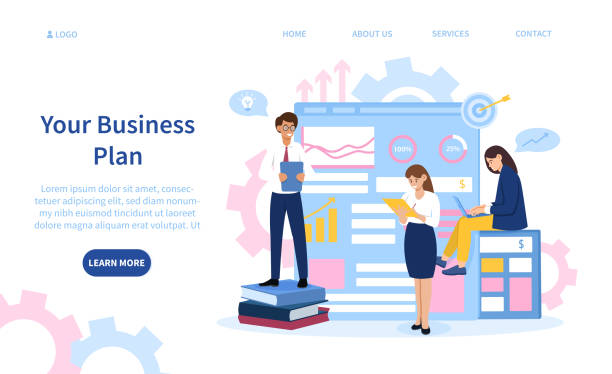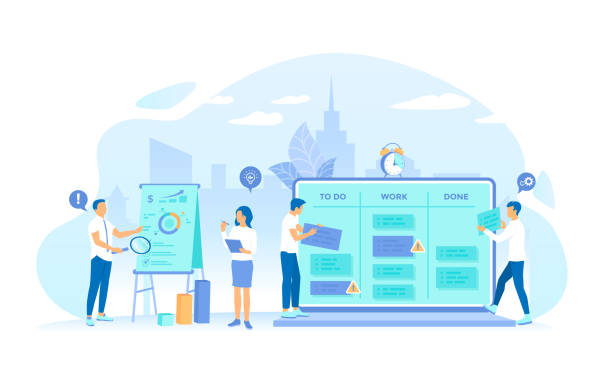Introduction to the World of Multilingual Website Design

In today’s world, where geographical boundaries are fading and global communication has become more important than ever, web design is no longer just about creating a page for local audiences.
The concept of #multilingual_website_design has emerged as a strategic necessity for businesses and organizations seeking to expand their presence in international markets.
This approach not only enables communication with a broader audience but also significantly helps in strengthening brand credibility and position globally.
A multilingual website is a platform that offers its content in multiple languages, allowing users from different parts of the world to access information in their native language.
The importance of multilingual website design goes beyond mere text translation; this concept involves a deep understanding of cultural differences, regional preferences, and even user search behaviors in various languages.
The main goal is to provide a seamless and localized user experience that makes global audiences feel comfortable and directly connected with your content.
This section, as an educational introduction, provides the foundation for understanding the reasons and benefits of moving towards multilingual website design and clarifies the importance of this approach in the era of globalization.
In fact, neglecting the need for multilingual websites can mean losing a significant share of the market and potential audiences.
Therefore, for any business that dreams of global expansion, investing in the design and implementation of a multilingual website is a vital and undeniable step.
This strategy not only helps increase site traffic but also significantly improves the conversion rate of visitors into customers.
Dreaming of a thriving online store but don’t know where to start?
RasaWeb is your comprehensive e-commerce website design solution.
✅ Attractive and user-friendly design
✅ Increased sales and revenue⚡ Get free consultation
The Undeniable Advantages of Multilingual Website Design for Businesses

Reaching new and broader markets is perhaps the most significant advantage of multilingual website design.
In a world where over half of internet users do not speak English, providing content in other languages opens access to millions of potential audiences.
This directly impacts SEO and site ranking in search engines across different countries.
When your content is available in the local language, the likelihood of users finding and interacting with it significantly increases.
This is particularly crucial for e-commerce businesses looking to sell their products or services globally.
Increased conversion rates are another key benefit; users are more inclined to purchase from or interact with a website whose content is presented in their native language.
Furthermore, multilingual website design helps improve user experience and reduce the Bounce Rate.
When a visitor comes to your site and can choose their preferred language, they feel more valued and respected, which in turn leads to a longer stay on the site and a deeper exploration of the content.
This analytical approach demonstrates how investing in multilingual website design can become a sustainable competitive advantage for businesses in international markets.
Brands that are pioneers in this field not only gain greater market share but are also recognized as industry leaders.
These benefits provide a comprehensive guide for any business seeking global growth and development.
Technical Considerations in Multilingual Website Development

Developing multilingual websites requires a deep understanding of technical considerations that impact accessibility and SEO.
One of the most important technical decisions is choosing the appropriate URL structure.
Three main approaches include subdomains, subdirectories, and country code top-level domains (ccTLDs).
Each of these options has its own advantages and disadvantages in terms of SEO, hosting, and management.
For example, ccTLDs like .de or .fr are very strong for targeting specific countries, but they are more expensive and require separate domain management.
Subdirectories (e.g., example.com/fr) are the most common and often recommended method, as they are easier to manage and share the authority of the main domain.
Subdomains (e.g., fr.example.com) are also an option, but search engines might consider them as separate sites.
In addition to URL structure, the correct use of hreflang tags is crucial for search engines.
These tags inform Google and other search engines which version of a page is intended for a specific language and region.
Incorrect use of these tags can lead to duplicate content issues and a decrease in search rankings.
This specialized and educational section precisely explains these issues and provides a comprehensive overview of how to correctly implement these technical elements in the multilingual website design process.
Furthermore, considering Content Management Systems (CMS) that support multilingual capabilities natively or through powerful plugins, such as WordPress with WPML or Polylang, is very important during the planning phase.
These technical decisions form the backbone of a successful multilingual website.
| Feature | Subdirectory (example.com/fr) | Subdomain (fr.example.com) | ccTLD (example.fr) |
|---|---|---|---|
| Ease of Management | High | Medium | Low |
| SEO Impact | Best for domain authority | May be seen as separate site | Strong for country targeting |
| Cost | Low | Low | High (requires purchasing new domains) |
| Geographic Targeting | Good (with hreflang) | Good (with hreflang) | Excellent (strong geographic signal) |
| Hosting | Usually unified | Usually unified | Can be separate |
Content Translation and Localization Strategies in Multilingual Website Design
![]()
The multilingual website design process is not limited to merely translating words from one language to another; it is a complex and multifaceted process that also includes localization.
Localization means adapting content to the cultural, social, and even legal differences of a specific region.
This includes aspects such as currency, date and time formats, phone numbers, addresses, colors, images, communication tone and style, and even jokes and cultural references.
Using machine translation (like Google Translate) for sensitive or crucial content can lead to disastrous results.
Instead, investing in native-speaking and expert translators who are familiar with the specific culture and idioms of each region is essential to ensure content quality and accuracy.
This approach provides guidance on how to avoid common translation mistakes and produce content that is not only accurate but also resonates with the local audience.
For example, an image that is perfectly normal in one culture might be considered offensive in another.
Colors have different meanings across various cultures, and even text layout (e.g., right-to-left for Persian and Arabic or left-to-right for English) must be implemented correctly.
A thought-provoking question in this regard could be: Can artificial intelligence be fully trusted for localization? The answer is often that while AI has made significant advancements, cultural nuances and human humor still require human intervention and oversight.
This is a deep explanation of the cultural and linguistic dimensions of multilingual website design, which significantly contributes to your site’s true success in global markets.
Tired of losing customers due to poor e-commerce website design? With RasaWeb, solve this problem forever!
✅ Increase sales and visitor-to-customer conversion rates
✅ Create an enjoyable user experience and boost customer trust⚡ Get free consultation
Optimizing Multilingual Websites for Search Engines (SEO)

Optimizing a multilingual website for search engines (SEO) requires specific strategies distinct from traditional SEO.
The first step is to conduct keyword research in each target language.
Popular keywords in one language may not have a direct translation or may not be popular in another.
This research should be done by native speakers using local tools.
Also, On-Page optimization, such as Title Tags, Meta Descriptions, and Headings, must be done separately for each language using local keywords.
The URL structure, explained in previous sections, also plays a significant role in international SEO.
Proper use of hreflang tags helps search engines display the correct content version to users in different geographical regions and prevents duplicate content issues.
For SEO in multilingual website design, registering the site in Google Search Console and setting international targeting for each language version is also essential.
This specialized and educational section helps site managers gain a comprehensive view of their site’s performance in different markets and identify and resolve potential issues.
Creating an XML Sitemap for each language and submitting it to search engines helps them discover and index all language versions.
Paying attention to these technical points and localized SEO not only increases organic traffic but also leads to an improved brand position in search results worldwide.
This is an analytical approach that ensures your investment in a multilingual site will yield maximum returns.
User Experience (UX) in Multilingual User Experience Design

User Experience (UX) plays a pivotal role in the overall success of a website in multilingual user experience design.
A good multilingual website, beyond providing accurate translations, must ensure that users in every language and culture have a smooth and natural experience.
One important aspect is the language switcher mechanism.
This switcher should be easily discoverable and usable, typically located in the header or footer of the site, and it is better to use the full name of the language (e.g., “فارسی” instead of the Iranian flag) rather than country flags, as flags can be confusing or even offensive in some cases.
Consistency and uniformity in design across all language versions are also crucial.
Fonts, colors, layout, and navigation should be consistent across all languages, unless specific changes are required for cultural localization.
For languages like Persian or Arabic, which are read from right-to-left (RTL), the design must be completely mirrored to provide a natural user experience.
This includes the arrangement of elements, text direction, and even the direction of buttons and forms.
This section serves as a comprehensive guide for web designers and developers, emphasizing the importance of paying attention to cultural details and design to provide a flawless user experience on multilingual sites.
A website with poor UX, even if it has excellent content, cannot properly attract its audience, and this is an essential explanation in the field of multilingual web design that should not be overlooked.
Tools and Platforms for Multilingual Website Design
![]()
For success in multilingual website design, choosing the right tools and platforms is of paramount importance.
Content Management Systems (CMS) like WordPress, Drupal, and Joomla are popular choices, each providing multilingual capabilities either with plugins or native features.
WordPress, with plugins like WPML (WordPress Multilingual Plugin) and Polylang, allows users to easily manage and display content in different languages.
Drupal offers stronger native multilingual features and is more suitable for large and complex projects.
In addition to CMSs, Translation Management Systems (TMS) are also vital tools for managing large volumes of translations.
These systems allow translation teams to work more efficiently, create glossaries and translation memories, which helps maintain consistency and reduce translation costs in the long run.
There are also other specialized tools for translation quality control, international SEO, and localization of images and videos.
This educational and explanatory section helps you optimize the implementation process of a multilingual site by selecting the right tools and ensure its high efficiency.
Investing in appropriate tools guarantees that your multilingual website design project will be executed effectively and with high quality.
| CMS Platform | Multilingual Support | Suitable for | Advantages | Potential Disadvantages |
|---|---|---|---|---|
| WordPress | With plugins (WPML, Polylang) | Small to medium sites, blogs | Ease of use, large user community, many plugins | Reliance on third-party plugins, less scalability for very large projects |
| Drupal | Strong native capabilities | Large and complex projects, web applications | High flexibility, strong security, high scalability | More complexity, requires higher technical expertise |
| Joomla | Native capabilities | Medium sites, portals | Balanced between WordPress simplicity and Drupal power, active user community | Updates can be challenging |
| Magento | Native for e-commerce stores | Large and complex online stores | Powerful for e-commerce, high flexibility | High cost, requires high technical expertise |
Common Challenges and Pitfalls in Multilingual Website Design

Despite numerous benefits, the challenges of multilingual website design are not few, and ignoring them can lead to project failure.
One of the biggest challenges is maintaining content consistency and integrity across all languages.
Ensuring that all language versions are up-to-date and no content is outdated or missing can become a management concern, especially when content is dynamically and constantly changing.
Another challenge is budget and resources.
Quality translation and localization are costly and require significant investment in translators, tools, and management processes.
SEO and technical issues can also be complex.
For example, problems related to hreflang tags, duplicate content, or domain/subdomain management can harm site rankings.
From a thought-provoking content perspective, is it really necessary to translate every single word of the website? Often, no.
Valuable and strategic content should be identified, and the focus should be on translating and localizing it, rather than indiscriminately translating everything.
This analytical section helps you identify these potential pitfalls and plan for them.
Managing multilingual projects requires strong coordination among various teams, including designers, developers, translators, and SEO specialists.
Ignoring these challenges can lead to project delays, increased costs, and ultimately, a poor user experience.
This is a clear explanation of the realities of multilingual website design.
Are your online sales not as expected? With RasaWeb, solve the problem of low sales and poor user experience forever!
✅ Increase visitor-to-customer conversion rates
✅ Create an enjoyable user experience and boost customer trust
⚡ Act now for a free consultation!
Measuring Success and the Future of Multilingual Website Design

Measuring the success of a multilingual website is crucial to ensure return on investment and future optimizations.
Tools like Google Analytics can be used to track the performance of each language version.
Key metrics include traffic from different regions, conversion rates for each language, time spent on site, bounce rate, and keyword rankings in local search engines.
Data analysis helps you understand which languages and regions yield the most returns and where improvements are needed.
The future of multilingual website design promises exciting advancements.
Artificial intelligence and machine learning will play an increasing role in automated translation and localization, making processes faster and more accurate.
Voice search in different languages and its use in multilingual SEO will also become a significant trend.
Content personalization based on language, culture, and even user behavior will elevate the user experience to new levels.
This news and analytical section provides insight into future directions in global web and demonstrates how emerging technologies can revolutionize multilingual website design.
Staying at the forefront of these developments helps you remain competitive and capitalize on new opportunities in global markets.
The Importance of Multilingual Website Design and Its Role in Global Presence

Ultimately, the importance of multilingual website design in today’s interconnected world is clearer than ever.
It’s not just an option; it’s a strategic necessity for any business looking to expand its reach beyond geographical borders.
A multilingual website is a gateway to new markets, increased brand awareness, improved relationships with international customers, and ultimately, sustainable revenue growth.
This approach allows businesses to speak to their audience in their own language, build trust, and eliminate cultural and linguistic barriers.
Investing in a multilingual website design means investing in the future of your business.
It’s not just a marketing tool, but also an expression of your respect for the cultural and linguistic diversity of the world.
This is an entertaining yet explanatory reminder of how technology can make the world a smaller, more accessible place.
From choosing the right URL structure and using hreflang tags to quality translation and content localization, every component of multilingual website design plays a role in creating an effective global digital presence.
In the digital age, language should no longer be a barrier to growth and innovation; instead, it should become a tool for connection.
Frequently Asked Questions
| Question | Answer |
|---|---|
| 1. What is multilingual website design? | The process of creating a website whose content is available in multiple languages so that users from around the world can interact with the site in their own language. |
| 2. Why should I make my website multilingual? | To expand your market, attract international audiences, improve SEO in global search results, and enhance brand credibility and professionalism. |
| 3. What are the methods for implementing a multilingual website? | Using subdomains (e.g., fa.example.com), subdirectories (e.g., example.com/fa/), URL parameters (e.g., example.com?lang=fa), or country-specific domains (e.g., .ir, .de). |
| 4. Is multilingual website SEO different? | Yes, it requires international SEO strategies such as using hreflang tags, appropriate URL structure for each language, and keyword research for each language. |
| 5. What points should be considered when choosing languages? | Language selection should be based on the target market, audience demographics, and current website traffic analysis data. |
| 6. What are the common problems in multilingual website design? | Issues related to SEO, translation quality, content management, right-to-left (RTL) and left-to-right (LTR) support, and user experience. |
| 7. What is the role of CMS in multilingual websites? | Modern Content Management Systems (CMS) (such as WordPress with multilingual plugins or Drupal) offer built-in features or powerful plugins for easy content management in multiple languages. |
| 8. How should content translation be done? | Translation should be done by native and professional translators, not just machine translation, to ensure local tone, culture, and idioms are respected. |
| 9. How is language switching done on multilingual websites? | Typically, a Language Switcher is used in the site’s header or footer, allowing users to easily select their preferred language. |
| 10. Is responsive design important for multilingual websites? | Yes, responsive design ensures that the site displays correctly on any device (mobile, tablet, desktop), which is crucial for international user access and SEO. |
And other services of RasaWeb Advertising Agency in the field of advertising
Smart SEO: Designed for businesses looking to increase click-through rates through marketing automation.
Smart UI/UX: A fast and efficient solution for user interaction focusing on attractive user interface design.
Smart Data Analysis: An innovative platform for improving SEO ranking by managing Google Ads.
Smart Google Ads: Designed for businesses seeking to analyze customer behavior through marketing automation.
Smart Link Building: A dedicated service for growing user engagement based on optimizing key pages.
And over hundreds of other services in the field of internet advertising, advertising consultation, and organizational solutions
Internet Advertising | Advertising Strategy | Advertorial
Sources
Multilingual Website Design Guide
International SEO Tips
Global Web Strategy
How to Build a Global Website
RasaWeb Afarin Digital Marketing Agency, accompanying you on the fast track of your business growth with professional services such as corporate website design and SEO optimization.
📍 Tehran, Mirdamad Street, Next to Central Bank, Southern Kazeroun Alley, Ramin Alley, No. 6

